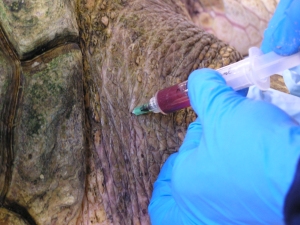Grant: 05-033R
Project Title: Pharmacokinetics of Meloxicam in Loggerhead Sea Turtles (Caretta caretta)
Project Manager: Dr. Tonya Clauss
Organization: The Florida Aquarium (Non-Profit Organization)
Grant Amount: $13,070.40
Completion Date: 2007-10-12
Summary: For this project, we will perform an intravenous pharmacokinetic analysis of meloxicam in loggerhead sea turtles (Caretta caretta) to establish an appropriate dosing regime and to help define the disposition of the this nonsteroidal anti-inflammatory drug (NSAID), allowing for accurate and dependable IM and PO pharmacokinetic studies in the future. Sea turtles, all species of which are threatened or endangered, often present to rehabilitation facilities suffering from wounds, entanglements, fractures or other presumed painful or inflammatory conditions. Extensive literature review and investigation reveal no pharmacokinetic studies on any class of analgesic or anti-inflammatory in sea turtles. Veterinarians may administer corticosteroids, opioids or nonsteroidal anti-inflammatory drugs to try to alleviate the pain and inflammation associated with a turtles injury or illness. These animals are frequently immunosuppressed, contraindicating the use of steroids, and a recent study cast doubt on the efficacy of opioids in reptiles. While NSAIDs have been used and studied extensively in mammalian species and to a lesser extent in avian species, only one study on the pharmacokinetics of an NSAID, meloxicam, has been carried out in a reptile species, that being the iguana. Meloxicam is a COX-2 preferential NSAID. Research indicates that COX-2 inhibitors serve as a promising therapeutic option not only for the treatment of inflammatory states but also for cancer, which could potentially benefit sea turtles suffering from fibropapillomatosis. Meloxicam has been used in Canada and Europe since 1994 and in the United States since 2003 in various domestic and exotic species, including reptiles. Currently, dosing regimes must be extrapolated from mammalian species, thus why a pharmacokinetic analysis is warranted.  Results: Seven healthy, sub-adult to adult (>59 cm standard length) loggerhead sea turtles ranging in weight from 47.9 – 155 kilograms were used in the study. The turtles were provided by Sea World Orlando, Clearwater Marine Aquarium and the Georgia Aquarium. Plasma samples were analyzed by reverse-phase high performance liquid chromatography (HPLC) with ultraviolet (UV) detection to determine the concentrations of meloxicam. A drug reference standard (analytical reference standard) of meloxicam was supplied by Boehringer Ingelheim. Calibrations and quality control (QC) determinations were prepared from blank plasma collected at pre-trial PE from experimental animals and spiked with the reference drug standard to validate the HPLC analysis and perform QC assessments during the assay. A Zorbax RX-C8 4.6mm x 150mm reverse-phase column (Agilent Technologies, Wilmington, DE) and solid-phase extraction cartridges were used for separation and extraction of meloxicam. A computer program (WinNonlin, Version 54.0, Pharsight Corporation, Mountain View, CA) was used to determine pharmacokinetic parameters. Both two- and three-compartment models were fitted to the data. For each analysis, there were severe outliers and high variability among some parameters. Therefore, a non-compartmental analysis was performed that did not assume any compartmental structure. In this analysis, the mean half-life (harmonic mean) was 7.25 hours, the volume of distribution at steady-state (VDSS) was 201.1 (±287.3) mL/kg, and the systemic clearance was 19.2 (±4.3) mL/kg/hr. Mean residence time (MRT) was 10.5 (± 14.2) hours. The low VDSS is consistent with NSAIDs in other species and is attribued to high protein binding. The clearance in turtles was higher than reported for dogs. The half-life observed in these animals was also faster than in dogs, which is probably a result of the higher clearance. The relatively rapid elinination rate and clearance may necessitate higher doses and/or more frequent intervals to maintain effective plasma concentrations. Sufficient information was obtained for planning the IM and PO single dose trials, and the information will be used in planning future multiple dose IV and IM studies. (Author: Dr. Tonya Clauss)
Results: Seven healthy, sub-adult to adult (>59 cm standard length) loggerhead sea turtles ranging in weight from 47.9 – 155 kilograms were used in the study. The turtles were provided by Sea World Orlando, Clearwater Marine Aquarium and the Georgia Aquarium. Plasma samples were analyzed by reverse-phase high performance liquid chromatography (HPLC) with ultraviolet (UV) detection to determine the concentrations of meloxicam. A drug reference standard (analytical reference standard) of meloxicam was supplied by Boehringer Ingelheim. Calibrations and quality control (QC) determinations were prepared from blank plasma collected at pre-trial PE from experimental animals and spiked with the reference drug standard to validate the HPLC analysis and perform QC assessments during the assay. A Zorbax RX-C8 4.6mm x 150mm reverse-phase column (Agilent Technologies, Wilmington, DE) and solid-phase extraction cartridges were used for separation and extraction of meloxicam. A computer program (WinNonlin, Version 54.0, Pharsight Corporation, Mountain View, CA) was used to determine pharmacokinetic parameters. Both two- and three-compartment models were fitted to the data. For each analysis, there were severe outliers and high variability among some parameters. Therefore, a non-compartmental analysis was performed that did not assume any compartmental structure. In this analysis, the mean half-life (harmonic mean) was 7.25 hours, the volume of distribution at steady-state (VDSS) was 201.1 (±287.3) mL/kg, and the systemic clearance was 19.2 (±4.3) mL/kg/hr. Mean residence time (MRT) was 10.5 (± 14.2) hours. The low VDSS is consistent with NSAIDs in other species and is attribued to high protein binding. The clearance in turtles was higher than reported for dogs. The half-life observed in these animals was also faster than in dogs, which is probably a result of the higher clearance. The relatively rapid elinination rate and clearance may necessitate higher doses and/or more frequent intervals to maintain effective plasma concentrations. Sufficient information was obtained for planning the IM and PO single dose trials, and the information will be used in planning future multiple dose IV and IM studies. (Author: Dr. Tonya Clauss)